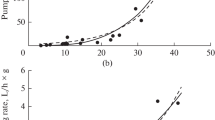Abstract
Pumping rates in Mytilus edulis L. were measured by means of a “constant-level-tank” method, in which hydrostatic pressure differences between inhalant and exhalant water levels were recorded by means of a laser beam reflected from a tethered mirror floating on the water surface. Hydrostatic pressure gradients were determined to ±0.05 mm H2O or better. The developed technique of directly measuring pumping rates in mussels is not subject to the artefacts of other methods. The pumping rates measured in M. edulis were substantially higher than those previously determined by means of direct techniques, but similar to the maximum filtration rates, as obtained by means of two indirect techniques, i.e. about 50 ml min-1 for a 0.15 g dry weight mussel. Positive hydrostatic pressures drastically affected water pumping. The pumping rate decreased linearly with increasing hydrostatic pressures towards a maximum pump pressure between 3 and 5 mm H2O. Negative pressures only affected the pumping rate slightly or insignificantly, except when the mussels were exposed to rapidly increasing negative pressures. Under this condition a shunt was presumably established between the inner demibranchs, allowing water to bypass the gills.
Similar content being viewed by others
Literature cited
Davids, C.: The influence of suspensions of microorganisms of different concentrations on the pumping and retention of food by the mussel (Mytilus edulis L.). Neth. J. Sea Res. 2, 233–249 (1964)
Drinnan, R. E.: An apparatus for recording the water-pumping behaviour of lamellibranchs. Neth. J. Sea Res. 2, 223–232 (1964)
Foster-Smith, R. L.: Some mechanisms for the control of pumping activity in bivalves. Mar. Behav. Physiol. 4, 41–60 (1976)
Galstoff, P. S.: New methods to measure the rate of flow produced by the gills of oysters and other mollusca. Science, Wash. D.C. 63, 233–234 (1926)
Hildreth, D. I.: The influence of water flow rate on pumping rate in Mytilus edulis using a refined direct measurement apparatus. J. mar. biol. Ass. U.K. 56, 311–319 (1976)
Jørgensen, C. B.: On gill function in the mussel Mytilus edulis L. Ophelia 13, 187–232 (1975)
Møhlenberg, F. and H. U. Riisgård: Efficiency of particle retention in 13 species of suspension feeding bivalves. Ophelia 17, 239–246 (1978)
Møhlenberg, F. and H. U. Riisgård: Filtration rate, using a new indirect technique, in thirteen species of suspension-feeding bivalves. Mar. Biol. 54, 143–148 (1979)
Riisgård, H. U.: On measurements of the filtration rates of suspension feeding bivalves in a flow system. Ophelia 16, 167–173 (1977)
Riisgård, H. U. and F. Møhlenberg: An improved automatic recording apparatus for determining the filtration rate in Mytilus edulis as a function of size and algal concentration. Mar. Biol. 52, 61–67 (1979)
Author information
Authors and Affiliations
Additional information
Communicated by T. Fenchel, Aarhus
Rights and permissions
About this article
Cite this article
Famme, P., Riisgård, H.U. & Jørgensen, C.B. On direct measurement of pumping rates in the mussel Mytilus edulis . Marine Biology 92, 323–327 (1986). https://doi.org/10.1007/BF00392672
Accepted:
Published:
Issue Date:
DOI: https://doi.org/10.1007/BF00392672




